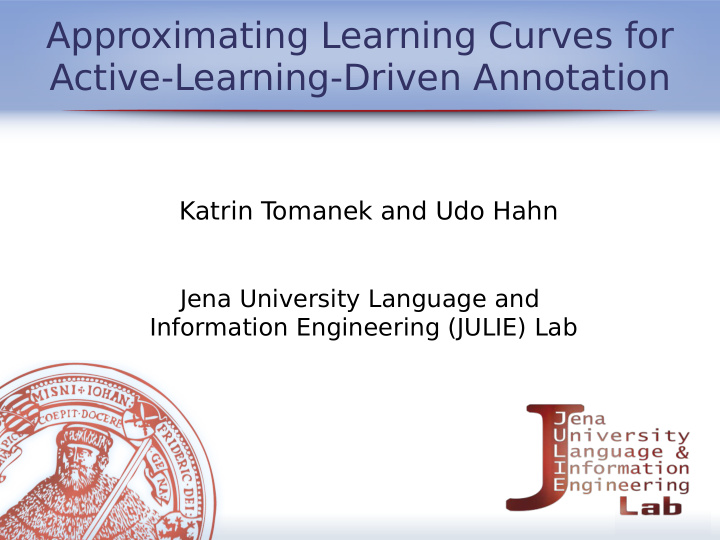



Approximating Learning Curves for Active-Learning-Driven Annotation Katrin T omanek and Udo Hahn Jena University Language and Information Engineering (JULIE) Lab
Agenda ● Introduction to Active Learning ● Stopping Conditions ● Experiments & Results
Passive versus Active Selection passive annotation scenario (aka Random Sampling) annotation corpus selection labeled unlabeled
Passive versus Active Selection passive annotation scenario (aka Random Sampling) annotation corpus selection labeled unlabeled active annotation scenario (aka Active Learning) „intelligent“ example selection annotation labeled unlabeled
Committee-based AL Framework D 1 (P 1 ,P 2 ,P n ) u 1 : P 1 P 2 ... P n (3) calculate dis- ... ... agreement u k : P 1 P 2 ... P n D k (P 1 ,P 2 ,P n ) (4) (2) select by dis- predict U AL pool: agreement labels unlabeled examples (1) committee: (5) train on labeled C 1 C 2 C n annotate examples subsets ... (bagging)
Reduction of Annotation Effort learning curves
Reduction of Annotation Effort learning curves > 50% reduction F=0.83 60K tokens 130K tokens
When to Stop the Annotation ? learning curves
When to Stop the Annotation ? bad Could gain a lot by further annotation
When to Stop the Annotation ? bad bad Further annotation will not Could gain a lot increase classifier performance significantly by further annotation
When to Stop the Annotation ? bad better bad Further annotation will not Could gain a lot increase classifier performance significantly by further annotation
Stopping Condition based on Learning Curve ? Pro: stopping condition directly based on classifier ● performance Contra: requires labeled gold standard ● ➔ not applicable in practice as gold standard not available Goal: ● – Estimate the (progression of) learning curve without need for gold standard
Approximating the Learning Curve Approach: ● – Based on agreement among committee members – Does not require extra labeling effort – Agreement curve approximates progression of learning curve ➔ We can tell relative position in annotation process from it: ● relative trade-off between annotation effort and gain in classifier performance from it – Steep slope ? – Convergence ?
Approximating the Learning Curve Intuition: ● – Agreement among committee: ● Low in early AL iterations ● High in later ones ➔ When agreement among committee members converges, also learning curve does
Approximating the Learning Curve Where to calculate the agreement: ● – On separate validation set ● Not be involved in AL selection process itself ● Agreement values comparable over different AL iteration – Otherwise agreement curve often not reliable approximation due to „simulation dilemma“ ● When e.g. agreement calculated on examples selected in each AL iteration: – Approximation of learning curve usually works well in simulation scenarios, because... » few hard cases left in later AL iterations (perfect agreement) – But fails in real-world annotation scenarios, because... » in practice AL will always find tricky cases...
Experiments For annotation of Named Entity mentions ● Whole sentences selected (20 each round) ● Simulation on CoNLL-2003 corpus ● – News-paper, MUC entities (PERS, LOC, ORG) – AL pool: ~ 14,000 sentences – Gold Standard: ~ 3,500 sentences ● For learning curve ● For agreement curve (labels ignored)
Results learning curves agreement curve
Summary & Conclusions AL has high potential to reduce annotation effort ● Proper stopping point necessary to profit from savings ● ➔ Method to monitor progress of annotation needed Agreement curve ● – Works well: good approximation of learning curve – No extra annotation effort: does not require labeled gold standard
Approximating Learning Curves for Active-Learning-Driven Annotation Thanks. Questions ? http://www.julielab.de/
Recommend
More recommend